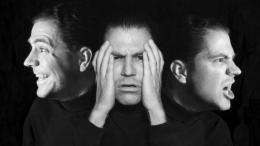Multiple Symptoms Can Point to Bipolar Disorder

(PhysOrg.com) -- When it comes to bipolar disorder, a successful diagnosis can be challenging.
The National Institute of Mental Health (NIMH) defines bipolar disorder (also known as manic-depressive illness) as a brain disorder that causes unusual shifts in mood, energy, activity levels and the ability to carry out day-to-day tasks. Patients can experience either depression or mania, or a combination of both.
"What can make bipolar disorder particularly difficult to identify is the wide variability of symptoms,” says Caleb Adler, MD, a UC Health psychiatrist and associate professor in the psychiatry and behavioral neuroscience department at the University of Cincinnati (UC).
"Patients often suffer from depression for long periods of time, which goes far beyond usual sadness. To diagnose bipolar disorder, though, we also look for manic episodes. These episodes are more than just feeling good—they’re marked by extreme mood elevations, extreme irritability and severe changes in sleep patterns or energy level.
"While everyone goes through ups and downs in mood, a person with bipolar disorder loses the ability to function during a manic episode. He or she might stay up all night to study for a test, for example, but get nothing done because of jumping from one idea to another,” Adler continues.
"In the end, it comes down to behavior. It’s out of proportion to the circumstances, like a level of irritability that’s more than just being grumpy. Manic patients may get into fights with family members, or even strangers.”
Manic episodes, according to Adler, can also take the form of over-involvement in pleasurable activities. "It can be a lot of things,” he says, "from spending sprees to traveling to dangerous or impulsive sexual behavior.”
To diagnose bipolar disorder, a doctor will commonly conduct a physical examination, an interview and a complete diagnostic evaluation. Because bipolar disorder is strongly genetic, the doctor will likely discuss family history of bipolar disorder or other mental illnesses with the patient—and possibly a close relative or spouse.
Brain scans, while conducted as part of bipolar research, cannot currently identify bipolar disorder. A doctor would conduct a scan as part of the diagnosis only to rule out possible factors contributing to the patient’s behavior, such as a stroke or brain tumor.
There is no known cure for bipolar disorder, according to the NIMH. If it is diagnosed, Adler says, medication is almost always part of any treatment plan because severe bipolar disorder is not likely to respond to therapy alone.
"That said, there are therapeutic techniques that are very effective and in conjunction with medication can be much more effective than medication alone,” Adler continues.
Common medications include the classic mood stabilizer lithium (brand names Eskalith CR, Eskalith, Lithobid). Anticonvulsant medications, usually used to treat seizures, also help control moods and are commonly used to treat bipolar disorder. Several newer medications have recently been approved by the FDA, as well.
"There are a lot more treatment options than existed even 10 years ago,” Adler says.















